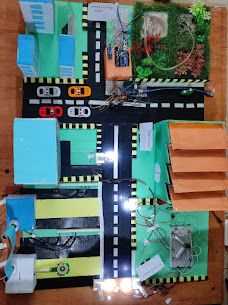Introduction:
A line-following robot is an autonomous robot designed to follow a predefined path, typically marked
by a black line on a white surface. It utilizes IR sensors to detect the path and makes real-time decisions
to adjust its movement accordingly. This project implements a line-following robot using an Arduino
Nano, motor driver, IR sensors, and a combination of buck and boost converters for stable power supply.
[1]
The line-following robot operates using an array of IR sensors that detect the black line on a white
surface. These sensors provide input to the Arduino Nano, which processes the signals and determines
the required movement. Based on the sensor readings:
• If only one sensor detects the line, the robot moves forward.
• If multiple sensors detect the line on one side, the robot turns in that direction.
• If no sensor detects the line, the robot stops.
The motor driver (L298N) controls the DC motors based on Arduino's commands, while the buck and
boost converters ensure stable voltage levels for different components. [3]
Robotics technology is increasingly in demand across various human endeavors, particularly in the
manufacturing, healthcare, service, defense, and consumer sectors. LFR can be utilized for a variety of
industrial tasks. It can be used to transport hazardous and large goods. Transporting radioactive materials
inside a factory poses a serious risk to human life. In that section, a line follower robot can be useful. It
may also monitor patients and alert doctors in emergency scenarios in a hospital. This type of robot can
be useful in many areas of the restaurant industry as well, such as food servers and order takers etc.
Apparatus:

Circuit diagram:
View angle:
Flow chart:
Result and Discussion: The line-following robot (LFR) is designed to follow black lines on a lighter surface. The critical value
for detecting black lines is when IR sensor readings fall below 512. In the code, the condition `s[i] = (s[i]
> threshold) ? 0 : 1` assigns `1` to readings ≤ 512 (line detected) and `0` to readings > 512 (no line). The
PID system utilizes this detection to adjust motor speeds, maintaining alignment with the line.
The threshold of 512 is effective because black lines reflect less light, resulting in sensor readings ≤ 512,
while the lighter surface produces readings > 512. This aligns with the LFR’s configuration for a darker
line. The `readSensors()` function computes the line’s position via a weighted sum, feeding the error into
the PID controller (`kp = 0.2`, `kd = 20`) to steer the robot. It turns left for a negative error (line left) and
right for a positive error (line right).Variations in line reflectivity or lighting could require threshold
adjustments. Currently, 512 ensures consistent line detection under the tested conditions.






















